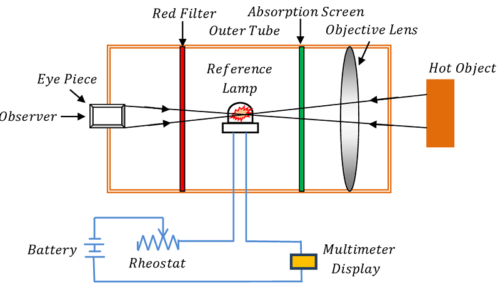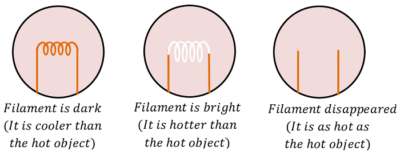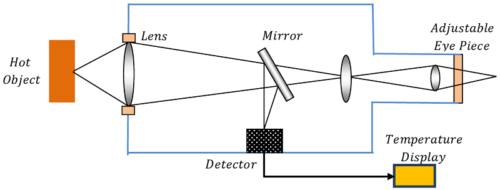What is called a Radiation Thermometer?
Radiation thermometer is a non-contact thermometer used to detect the temperature of an object from a far distance. Thermometer absorbs the radiant energy (either visible range or invisible infrared) and measure the electro-magnetic wave intensity of radiation to get the temperature.
The radiation thermometer is used to measure very high temperatures like temperature of melting furnaces etc. These devices can measure the temperature very accurately, precisely and quickly.
Radiation thermometers are of two types –
- Infrared thermometer – These are capable to absorb the invisible range of radiations called infrared radiations to measure the temperature of the source.
- Pyrometers – These are capable to absorb the visible range of radiations to measure the temperature of the source.
The process of measurement using radiation thermometers is called pyrometry or radiometry.
Pyrometer
Pyrometers are the radiation type of temperature measuring devices used to measure the temperature of an object emitting electromagnetic radiations.
Pyrometers are available in different spectral ranges ( because metals radiate short wavelength radiations and non metals radiate long wavelength radiations).
Based on the spectral range, pyrometers are classified into (1) 1-color pyrometers (2) 2-color pyrometers and (3) high-speed pyrometers.
Applications of Pyrometers
Pyrometers are used for the measurement of hot moving objects or a surface which cannot be reached or touched. It has versatile uses –
- Multispectral pyrometers are suitable for measuring high temperatures inside combustion chambers of gas turbine engines with high accuracy.
- Temperature is a fundamental parameter in metallurgical furnace operations. Pyrometers are used for reliable and continuous measurement of temperature in metallurgical processes such as melting, smelting, casting and heat treatment.
- Pyrometers may be fitted to gas turbine engines to measure the surface temperature of moving turbine blades.
Working Principle of Pyrometer
A pyrometer works on the principle of Stefan Boltzmann’s law of black body radiations. Stefan-Boltzmann law of energy radiation states that –
The heat energy emitted by a perfect black body per second per unit area is directly proportional to the fourth power of its absolute temperature.
Therefore, if E represents the total radiation energy emitted by a body with surface absolute temperature T , then –
\quad E \propto T^4 \quad Or, \quad E = \sigma T^4 .
Here ( \sigma ) is a universal constant called Stefan-Boltzmann constant. In SI system of measurement \quad \sigma = 5.67 \times 10^{-8} W m^{-2} K^{-4}
Any Pyrometer has two basic components (1) an optical system and (2) detector.
When the device is brought near the hot object, the optical system captures the radiant energy emitted from that object. This radiation is then focuses and sent to the detector. Detector is very sensitive to the electromagnetic waves of radiation. It senses the intensity of radiant energy and process into electrical signals to give output as the temperature level of the object.
Types of Pyrometer
To detect the different temperatures, pyrometers are classified into 2 types. They are –
- Optical Pyrometers.
- Infrared Or Radiation pyrometers.
These are explained as below –
Optical Pyrometer
An optical pyrometer is used to detect the thermal radiation of visible range of spectrum. It works on the principle that, brightness of a visible light emitted from a hot object depends on the temperature of that object.
Thus, an optical pyrometer works by comparing the brightness of a calibrated lamp filament with the hot object surface.
When the temperature of the lamp filament and the hot object surface matches, the thermal radiations from the lamp filament and from the hot object surface also matches. This causes the filament to become invisible. When this condition is fulfilled, the electric current passing through the filament is converted into a temperature scale, which represents the temperature of hot object.

Working of an optical pyrometer is shown in figure. It has the following components –
- An eye piece at the left side and an optical lens on the right.
- A reference lamp whose power can be varied with the help of a battery.
- A rheostat to change the current and hence the brightness of reference lamp.
- An absorption screen is fitted between the optical lens and the reference lamp to increase the temperature range of the device.
- A red filter is placed between the eye piece and the reference lamp to narrowing the band of wavelength reaching the eye piece.
Working Principle of Optical Pyrometer
The radiation emitted from the hot object is captured by the optical lens. The lens focuses this radiation on the reference lamp. From the eye piece, the observer can see the images of lamp filament and hot object. Observer can adjust the device so that the lamp filament has a sharp focus super-imposed on the image of hot object on the lens. The observer then adjust the rheostat to vary the current to change the brightness of the reference lamp. Changing brightness of reference lamp can result following three types of observations as shown in figure.

These observations can be explained as follows –
- When the filament appears dark in comparison to the hot object, the filament temperature is lower than the hot object.
- When the filament appears bright, it is hotter than the hot object.
- At a stage, when the filament disappears, it means that the brightness of the filament and hot object is equal. At this stage, the current in the reference lamp circuit is measured which gives the value of the temperature of the radiated light of hot object.
Advantages of Optical Pyrometer
Optical pyrometer has following advantages –
- Easy to use due to simple adjustment of the device.
- Gives very high accuracy of reading.
- Contact-less measurement provide wide application in industries.
- No effect of distance between the device and the hot object to measure.
Disadvantages of Optical Pyrometer
An optical pyrometer has following disadvantages –
- As the measurement is based on the light intensity, the device can be used only in applications with a minimum temperature of 700 \degree C .
- It can be used only for incandescent hot bodies.
- The device is not useful for obtaining continuous values of temperatures at small intervals.
Radiation Pyrometer
Radiation pyrometer is a device used in places where physical contact temperature sensors like thermocouple and thermistors fail because of very high temperature of the source.
Working Principle of Radiation Pyrometer
The main theory of a radiation pyrometer is that, the heat radiation emitted from a hot body is a function of its surface temperature.
Working procedure of a radiation pyrometer is shown in figure.

It consists of (1) an optical system including a lens, a curved mirror and an adjustable eye piece (2) a detector and temperature display unit.
The heat energy emitted from the hot object is passed through the optical lens and falls on mirror and eye piece arrangement. Mirror collects the radiation and focuses on to the detector with the help of the eye piece.
The detector is consists of a thermistor or photomultiplier tubes. Here, the heat energy is converted into its corresponding electrical signals, it is then sent to the output temperature display device.
Advantages of Radiation Pyrometer
A radiation pyrometer has following advantages –
- The device can be used to measure very high temperatures without direct contact with the hot source like molten metal.
- This device can be used for very small objects from far distances.
- It can be used for any type of hot objects either incandescent or not.
